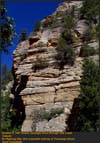|
The Toroweap ranges from 262 to 265 million years old. About 300 feet thick in the Sedona area, it outcrops in a limited area on the Mogollon Rim and adjacent areas. The Toroweap is a very sandy and resistant sandstone in the Sedona area, but changes to a limestone and gypsum deposit in Oak Creek Canyon. For the sandstones, the sediments represent a coastal marine dune deposit, with steeply cross bedded units. Some fossils have been found in the Toroweap. In the limestone Brady Canyon member, Permian clams and brachiopods have been reported. Some of the near shore dune deposits contain reptile tracks. CLICK ON THE FOLLOWING SELECTIONS FOR A LARGER VIEW: Along Highway 89a, the Toroweap outcrops in several localities along the "Slide Rock" area. Here, the extensive cross bedding can be seen clearly, in several different layers. The Toroweap is much whiter than the Coconino, and along with the much stronger cross beds, is an aid in differentiating them. A close up of the extremely defined cross bedding of the Toroweap along Highway 89a out of Sedona. While some of the layers are obviously dune deposits with the wind driven cross beds, seen here the more laminar layers were more water deposited, in a near or in shore environment to form horizontal beds with no cross bedding. One of the best views of the cross bedding patterns of the Toroweap is along 89a, just past Slide Rock. This magnificent tower of sandstone is on a sharp corner with no place to park and fast cars whizzing by! However, the very distinct eolian deposited dunes, form sharp cross beds. With a small amount of the yellow Coconino Sandstone near the base, this cliff face of Toroweap Sandstone was shot from Highway 89a just outside of Sedona. A unique characteristic of this unit is the isolated towers that break free and form individual units along the edges. One is seen here to the left on this image. I have never seen the Coconino do this, and this can be used also as an aid to differentiate the two. Columnar towers beginning to break away from a cliff face of the Toroweap on Highway 89a. This is one of the purest white sandstones, and actual pieces of it are very gritty, with large well sorted clear frosted grains. Viewing the Toroweap towers from above. At the overlook just past Slide Rock, we can see in a deep canyon known as Oak Creek Canyon. The individual towers are a bit oval in cross section, but clearly well isolated on their tops from other towers. |





